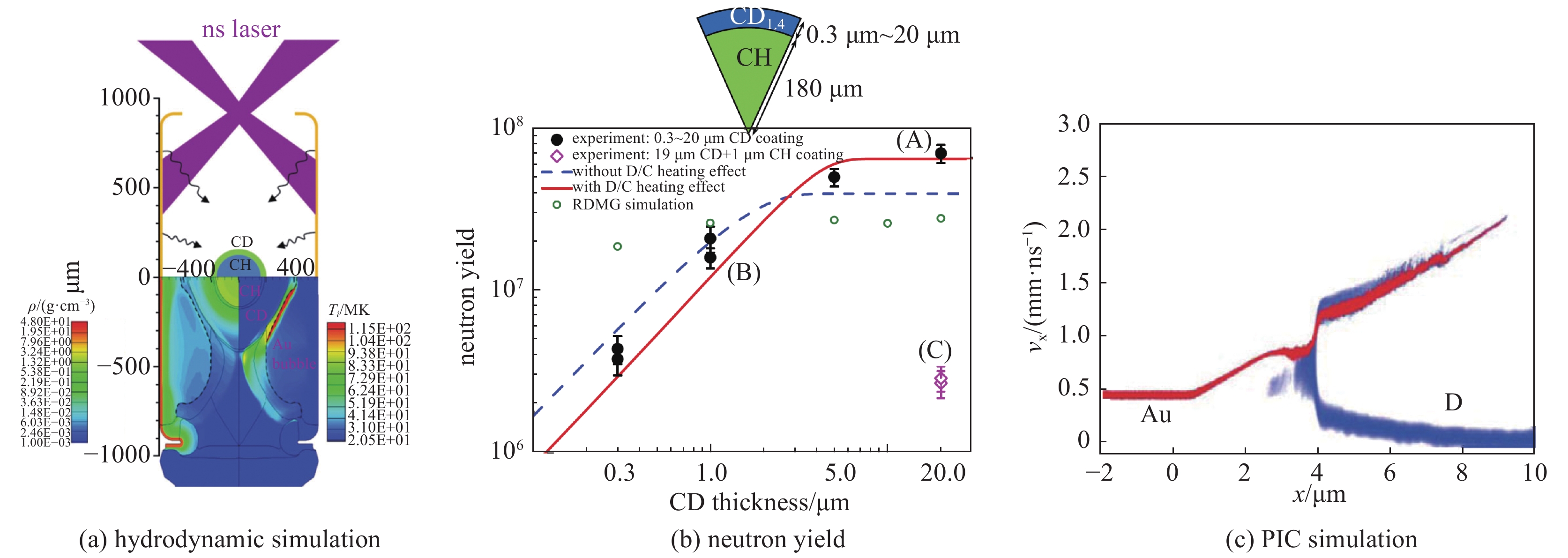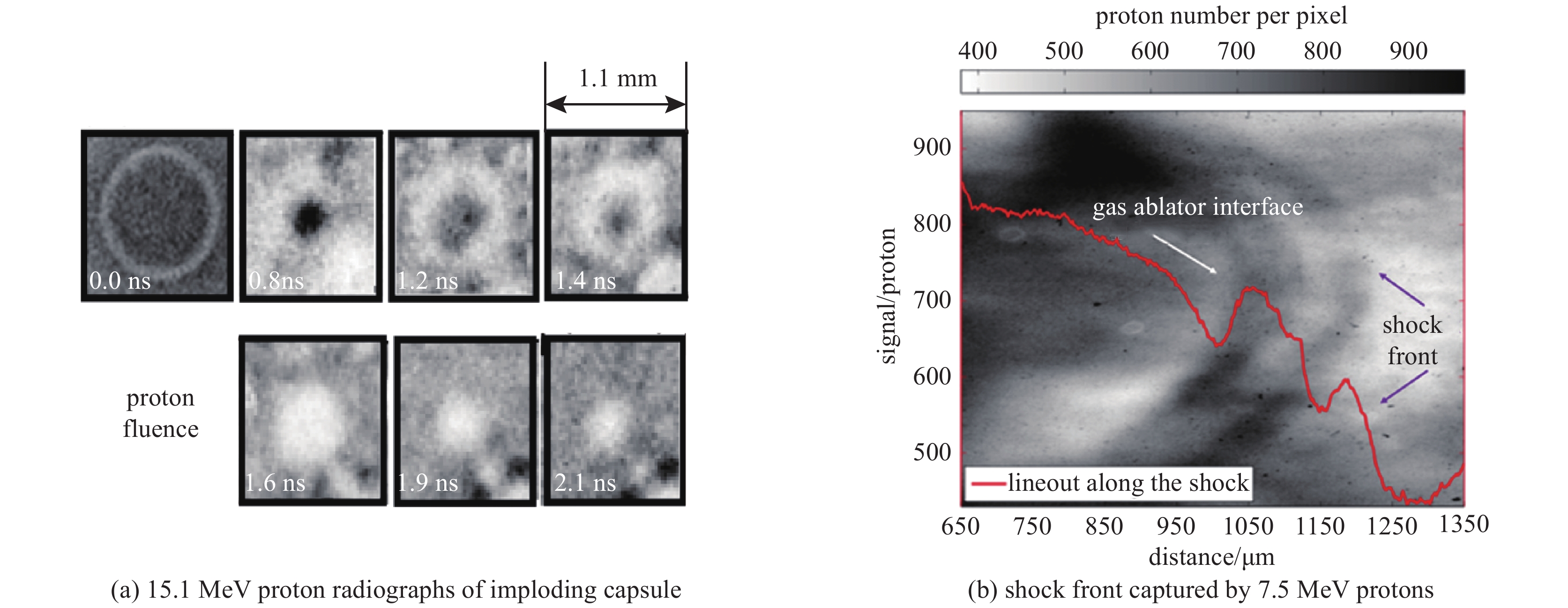Research progress of kinetic effects in laser inertial confinement fusion
-
摘要: 动理学效应的研究是近年来激光惯性约束聚变领域的研究热点,有助于理解实验结果和传统流体模拟之间的偏差。间接驱动黑腔中等离子体的温度、密度跨越多个量级且靶丸组分复杂,在局域的高温低密度区域,粒子的非平衡效应开始变得显著,可能会间接影响内爆性能。对ICF领域动理学效应的概念和部分进展做了简要综述。Abstract: In recent years, the study of kinetic effects is a hot issue in the field of laser inertial confinement fusion, which helps to understand the deviation between experimental results and traditional fluid simulation. The temperature and density of the plasma in indirect-drive hohlraum span multiple orders of magnitude, and the composition of capsule is complex. In the local high temperature and low density region, the thermal non-equilibrium effect of particles becomes significant, which may indirectly affect the implosion performance. In this paper, the concept and some progress of kinetic effects in the ICF field are briefly reviewed.
-
Key words:
- laser fusion /
- kinetic effect /
- thermal non-equilibrium
-
图 1 NIF170601发次对应模拟的黑腔等离子体不同区域温度、密度演化曲线(实线),及归一化离子碰撞平均自由程等高线(虚线)。(□)峰值激光功率时刻,(○)冲击波回弹时刻,(×)峰值燃烧时刻[15]
Figure 1. Physical regime of density and temperature in the simulation of NIF shot N170601 (solid lines). Contours show normalized ion mean-free-path (dashed lines). Symbols indicate time of (□) peak laser power,(○) shock rebound,and (×) peak burn[15]
-
[1] Lindl J D, Amendt P, Berger R L, et al. The physics basis for ignition using indirect-drive targets on the National Ignition Facility[J]. Physics of Plasmas, 2004, 11(2): 339-491. doi: 10.1063/1.1578638 [2] Hurricane O A, Callahan D A, Casey D T, et al. Fuel gain exceeding unity in an inertially confined fusion implosion[J]. Nature, 2014, 506(7488): 343. doi: 10.1038/nature13008 [3] Le Pape S, Berzak Hopkins L F, Divol L, et al. Fusion energy output greater than the kinetic energy of an imploding shell at the National Ignition Facility[J]. Physical Review Letters, 2018, 120: 245003. doi: 10.1103/PhysRevLett.120.245003 [4] Lindl J, Landen O, Edwards J, et al. Review of the National Ignition Campaign 2009-2012[J]. Physics of Plasmas, 2014, 21: 020501. doi: 10.1063/1.4865400 [5] Hurricane O A, Springer P T, Patel P K, et al. Approaching a burning plasma on the NIF[J]. Physics of Plasmas, 2019, 26: 052704. doi: 10.1063/1.5087256 [6] Betti R, Hurricane O A. Inertial-confinement fusion with lasers[J]. Nature Physics, 2016, 12(5): 435-448. doi: 10.1038/nphys3736 [7] 裴文兵,朱少平. 激光聚变中的科学计算[J]. 物理, 2009, 38(8):559-568. (Pei Wenbing, Zhu Shaoping. Scientific computing for laser fusion[J]. Physics, 2009, 38(8): 559-568 doi: 10.3321/j.issn:0379-4148.2009.08.005 [8] Marinak M M, Tipton R E, Landen O L, et al. Three-dimensional simulations of Nova high growth factor capsule implosion experiments[J]. Physics of Plasmas, 1996, 3(5): 2070-2076. doi: 10.1063/1.872004 [9] Clark D S, Weber C R, Milovich J L, et al. Three-dimensional modeling and hydrodynamic scaling of National Ignition Facility implosions[J]. Physics of Plasmas, 2019, 26: 050601. doi: 10.1063/1.5091449 [10] Mora P, Yahi H. Thermal heat-flux reduction in laser-produced plasmas[J]. Physical Review A, 1982, 26: 2259-2261. doi: 10.1103/PhysRevA.26.2259 [11] Matte J P, Lamoureux M, Moller C, et al. Non-Maxwellian electron distributions and continuum X-ray emission in inverse Bremsstrahlung heated plasmas[J]. Plasma Physics and Controlled Fusion, 1988, 30: 1665-1689. doi: 10.1088/0741-3335/30/12/004 [12] Zhang W S, Cai H B, Shan L Q, et al. Anomalous neutron yield in indirect-drive inertial-confinement-fusion due to the formation of collisionless shocks in the corona[J]. Nuclear Fusion, 2017, 57: 066012. doi: 10.1088/1741-4326/aa686c [13] Clark D S, Kritcher A L, Milovich J L, et al. Capsule modeling of high foot implosion experiments on the National Ignition Facility[J]. Plasma Physics and Controlled Fusion, 2017, 59: 055006. doi: 10.1088/1361-6587/aa6216 [14] Hopkins L B, LePape S, Divol L, et al. Toward a burning plasma state using diamond ablator inertially confined fusion (ICF) implosions on the National Ignition Facility (NIF)[J]. Plasma Physics and Controlled Fusion, 2019, 61: 014023. doi: 10.1088/1361-6587/aad97e [15] Rinderknecht H G, Amendt P A, Wilks S C, et al. Kinetic physics in ICF: Present understanding and future directions[J]. Plasma Physics and Controlled Fusion, 2018, 60: 064001. doi: 10.1088/1361-6587/aab79f [16] Jones O S, Cerjan C J, Marinak M M, et al. A high-resolution integrated model of the National Ignition Campaign cryogenic layered experiments[J]. Physics of Plasmas, 2012, 19: 056315. doi: 10.1063/1.4718595 [17] Hopkins L F B, Meezan N B, Le Pape S, et al. First high-convergence cryogenic implosion in a near-vacuum hohlraum[J]. Physical Review Letters, 2015, 114: 175001. doi: 10.1103/PhysRevLett.114.175001 [18] Hopkins L F B, Le Pape S, Divol L, et al. Near-vacuum hohlraums for driving fusion implosions with high density carbon ablators[J]. Physics of Plasmas, 2015, 22: 056318. doi: 10.1063/1.4921151 [19] Le Pape S, Divol L, Huser G, et al. Plasma collision in a gas atmosphere[J]. Physical Review Letters, 2020, 124: 6: 025003. [20] Rosenberg M J, Rinderknecht H G, Hoffman N M, et al. Exploration of the transition from the hydrodynamiclike to the strongly kinetic regime in shock-driven implosions[J]. Physical Review Letters, 2014, 112: 185001. doi: 10.1103/PhysRevLett.112.185001 [21] Rinderknecht H G, Sio H, Li C K, et al. First observations of nonhydrodynamic mix at the fuel-shell interface in shock-driven inertial confinement implosions[J]. Physical Review Letters, 2014, 112: 135001. doi: 10.1103/PhysRevLett.112.135001 [22] Amendt P, Landen O L, Robey H F, et al. Plasma barodiffusion in inertial-confinement-fusion implosions: application to observed yield anomalies in thermonuclear fuel mixtures[J]. Physical Review Letters, 2010, 105: 115005. doi: 10.1103/PhysRevLett.105.115005 [23] Rinderknecht H G, Rosenberg M J, Li C K, et al. Ion thermal decoupling and species separation in shock-driven implosions[J]. Physical Review Letters, 2015, 114: 025001. doi: 10.1103/PhysRevLett.114.025001 [24] Bellei C, Rinderknecht H, Zylstra A, et al. Species separation and kinetic effects in collisional plasma shocks[J]. Physics of Plasmas, 2014, 21: 056310. doi: 10.1063/1.4876614 [25] Byvank T, Langendorf S J, Thoma C, et al. Observation of shock-front separation in multi-ion-species collisional plasma shocks[J]. Physics of Plasmas, 2020, 27: 042302. doi: 10.1063/1.5139239 [26] Sio H, Larroche O, Atzeni S, et al. Probing ion species separation and ion thermal decoupling in shock-driven implosions using multiple nuclear reaction histories[J]. Physics of Plasmas, 2019, 26: 072703. doi: 10.1063/1.5097605 [27] Li C K, Seguin F H, Frenje J A, et al. Charged-particle probing of X-ray-driven inertial-fusion implosions[J]. Science, 2010, 327(5970): 1231-1235. doi: 10.1126/science.1185747 [28] Li C K, Seguin F H, Frenje J A, et al. Impeding hohlraum plasma stagnation in inertial-confinement fusion[J]. Physical Review Letters, 2012, 108: 025001. doi: 10.1103/PhysRevLett.108.025001 [29] Li C K, Seguin F H, Frenje J A, et al. Proton imaging of hohlraum plasma stagnation in inertial-confinement-fusion experiments[J]. Nuclear Fusion, 2013, 53: 073022. doi: 10.1088/0029-5515/53/7/073022 [30] Hua R, Kim J, Sherlock M, et al. Self-generated magnetic and electric fields at a mach-6 shock front in a low density helium gas by dual-angle proton radiography[J]. Physical Review Letters, 2019, 123: 215001. doi: 10.1103/PhysRevLett.123.215001 [31] Amendt P, Wilks S C, Bellei C, et al. The potential role of electric fields and plasma barodiffusion on the inertial confinement fusion database[J]. Physics of Plasmas, 2011, 18: 056308. doi: 10.1063/1.3577577 [32] Dewald E L, Hartemann F, Michel P, et al. Generation and beaming of early hot electrons onto the capsule in laser-driven ignition hohlraums[J]. Physical Review Letters, 2016, 116: 075003. doi: 10.1103/PhysRevLett.116.075003 [33] Strozzi D J, Bailey D S, Michel P, et al. Interplay of laser-plasma interactions and inertial fusion hydrodynamics[J]. Physical Review Letters, 2017, 118: 025002. doi: 10.1103/PhysRevLett.118.025002 [34] Shan L Q, Cai H B, Zhang W S, et al. Experimental evidence of kinetic effects in indirect-drive inertial confinement fusion hohlraums[J]. Physical Review Letters, 2018, 120: 195001. doi: 10.1103/PhysRevLett.120.195001 [35] Cai H B, Shan L Q, Yuan Z Q, et al. Study of the kinetic effects in indirect-drive inertial confinement fusion hohlraums[J]. High Energy Density Physics, 2020, 36: 100756. doi: 10.1016/j.hedp.2020.100756 [36] Welch D R, Rose D V, Clark R E, et al. Implementation of an non-iterative implicit electromagnetic field solver for dense plasma simulation[J]. Computer Physics Communications, 2004, 164(1/3): 183-188. [37] Higginson D P, Amendt P, Meezan N, et al. Hybrid particle-in-cell simulations of laser-driven plasma interpenetration, heating, and entrainment[J]. Physics of Plasmas, 2019, 26: 112107. doi: 10.1063/1.5110512 [38] Mason R J, Kirkpatrick R C, Faehl R J. Real viscosity effects in inertial confinement fusion target deuterium-tritium micro-implosions[J]. Physics of Plasmas, 2014, 21: 022705. doi: 10.1063/1.4864641 [39] Mason R J. Implicit moment pic-hybrid simulation of collisional plasmas[J]. Journal of Computational Physics, 1983, 51(3): 484-501. doi: 10.1016/0021-9991(83)90165-1 [40] Le A, Kwan T J T, Schmitt M J, et al. Simulation and assessment of ion kinetic effects in a direct-drive capsule implosion experiment[J]. Physics of Plasmas, 2016, 23: 102705. doi: 10.1063/1.4965913 [41] Thoma C, Welch D R, Clark R E, et al. Hybrid-PIC modeling of laser-plasma interactions and hot electron generation in gold hohlraum walls[J]. Physics of Plasmas, 2017, 24: 062707. doi: 10.1063/1.4985314 [42] Hoffman N M, Zimmerman G B, Molvig K, et al. Approximate models for the ion-kinetic regime in inertial-confinement-fusion capsule implosions[J]. Physics of Plasmas, 2015, 22: 052707. doi: 10.1063/1.4921130 [43] Larroche O, Rinderknecht H G, Rosenberg M J, et al. Ion-kinetic simulations of D3He gas-filled inertial confinement fusion target implosions with moderate to large Knudsen number[J]. Physics of Plasmas, 2016, 23: 012701. doi: 10.1063/1.4939025 [44] Molvig K, Hoffman N M, Albright B J, et al. Knudsen layer reduction of fusion reactivity[J]. Physical Review Letters, 2012, 109: 095001. doi: 10.1103/PhysRevLett.109.095001 [45] Kagan G, Svyatskiy D, Rinderknecht H G, et al. Self-similar structure and experimental signatures of suprathermal ion distribution in inertial confinement fusion implosions[J]. Physical Review Letters, 2015, 115: 105002. doi: 10.1103/PhysRevLett.115.105002 [46] Albright B J, Molvig K, Huang C K, et al. Revised Knudsen-layer reduction of fusion reactivity[J]. Physics of Plasmas, 2013, 20: 122705. doi: 10.1063/1.4833639 [47] McDevitt C J, Tang X Z, Guo Z, et al. A comparative study of the tail ion distribution with reduced Fokker–Planck models[J]. Physics of Plasmas, 2014, 21: 032708. doi: 10.1063/1.4868732 [48] Asahina T, Nagatomo H, Sunahara A, et al. Validation of thermal conductivity in magnetized plasmas using particle-in-cell simulations[J]. Physics of Plasmas, 2017, 24: 042117. doi: 10.1063/1.4981233 [49] Li C K, Seguin F H, Frenje J A, et al. Diagnosing indirect-drive inertial-confinement-fusion implosions with charged particles[J]. Plasma Physics and Controlled Fusion, 2010, 52: 124027. doi: 10.1088/0741-3335/52/12/124027 [50] Kritcher A L, Hinkel D E, Callahan D A, et al. Integrated modeling of cryogenic layered highfoot experiments at the NIF[J]. Physics of Plasmas, 2016, 23: 052709. doi: 10.1063/1.4949351 [51] Johnson M G, Knauer J P, Cerjan C J, et al. Indications of flow near maximum compression in layered deuterium-tritium implosions at the National Ignition Facility[J]. Physical Review E, 2016, 94: 021202. doi: 10.1103/PhysRevE.94.021202 [52] Rosenberg M J, Zylstra A B, Seguin F H, et al. Investigation of ion kinetic effects in direct-drive exploding-pusher implosions at the NIF[J]. Physics of Plasmas, 2014, 21: 122712. doi: 10.1063/1.4905064 [53] Rygg J R, Frenje J A, Li C K, et al. Tests of the hydrodynamic equivalence of direct-drive implosions with different D2 and 3He mixtures[J]. Physics of Plasmas, 2006, 13: 052702. doi: 10.1063/1.2192759 [54] Herrmann H W, Langenbrunner J R, Mack J M, et al. Anomalous yield reduction in direct-drive deuterium/tritium implosions due to 3He addition[J]. Physics of Plasmas, 2009, 16: 056312. doi: 10.1063/1.3141062 [55] Casey D T, Frenje J A, Johnson M G, et al. Evidence for stratification of deuterium-tritium fuel in inertial confinement fusion implosions[J]. Physical Review Letters, 2012, 108: 075002. doi: 10.1103/PhysRevLett.108.075002 [56] Amendt P, Bellei C, Ross J. S, et al Ion separation effects in mixed-species ablators for inertial-confinement-fusion implosions[J]. Physical Review E, 2015, 91: 023103. doi: 10.1103/PhysRevE.91.023103 [57] Rinderknecht H G, Amendt P A, Rosenberg M J, et al. Ion kinetic dynamics in strongly-shocked plasmas relevant to ICF[J]. Nuclear Fusion, 2017, 57: 066014. doi: 10.1088/1741-4326/aa69d9 [58] Forrest C J, Radha P B, Knauer J P, et al. First Measurements of deuterium-tritium and deuterium-deuterium fusion reaction yields in ignition-scalable direct-drive implosions[J]. Physical Review Letters, 2017, 118: 095002. doi: 10.1103/PhysRevLett.118.095002 [59] Hsu S C, Joshi T R, Hakel P, et al. Observation of interspecies ion separation in inertial-confinement-fusion implosions[J]. Europhysics Letters, 2016, 11: 65001. [60] Joshi T R, Hsu S C, Hakel P, et al. Progress on observations of interspecies ion separation in inertial-confinement-fusion implosions via imaging X-ray spectroscopy[J]. Physics of Plasmas, 2019, 26: 062702. doi: 10.1063/1.5092998 [61] Joshi T R, Hakel P, Hsu S C, et al. Observation and modeling of interspecies ion separation in inertial confinement fusion implosions via imaging x-ray spectroscopy[J]. Physics of Plasmas, 2017, 24: 056305. doi: 10.1063/1.4978887 [62] Sio H, Frenje J A, Katz J, et al. A particle X-ray temporal diagnostic (PXTD) for studies of kinetic, multi-ion effects, and ion-electron equilibration rates in inertial confinement fusion plasmas at OMEGA[J]. Review of Scientific Instruments, 2016, 87: 11d. [63] Sio H, Li C K, Parker C E, et al. Fuel-ion diffusion in shock-driven inertial confinement fusion implosions[J]. Matter and Radiation at Extremes, 2019, 4: 055401. doi: 10.1063/1.5090783 [64] Sio H, Frenje J A, Le A, et al. Observations of multiple nuclear reaction histories and fuel-ion species dynamics in shock-driven inertial confinement fusion implosions[J]. Physical Review Letters, 2019, 122: 035001. doi: 10.1103/PhysRevLett.122.035001 [65] Zylstra A B, Hoffman N M, Herrmann H W, et al. Diffusion-dominated mixing in moderate convergence implosions[J]. Physical Review E, 2018, 97: 061201. doi: 10.1103/PhysRevE.97.061201 [66] Zylstra A B, Herrmann H W, Kim Y H, et al. Simultaneous measurement of the HT and DT fusion burn histories in inertial fusion implosions[J]. Review of Scientific Instruments, 2017, 88: 053504. doi: 10.1063/1.4983923 [67] Bellei C, Amendt P A. Shock-induced mix across an ideal interface[J]. Physics of Plasmas, 2017, 24: 040703. doi: 10.1063/1.4979904 [68] Li C K, Seguin F H, Rygg J R, et al. Monoenergetic-proton-radiography measurements of implosion dynamics in direct-drive inertial-confinement fusion[J]. Physical Review Letters, 2008, 100: 225001. doi: 10.1103/PhysRevLett.100.225001 [69] Hua R, Sio H, Wilks S C, et al. Study of self-generated fields in strongly-shocked, low-density systems using broadband proton radiography[J]. Applied Physics Letters, 2017, 111: 034102. doi: 10.1063/1.4995226 [70] Glenzer S H, Rozmus W, Bychenkov V Y, et al. Anomalous absorption of high-energy green laser light in high-Z plasmas[J]. Physical Review Letters, 2002, 88: 235002. doi: 10.1103/PhysRevLett.88.235002 [71] Michel P, Divol L, Williams E A, et al. Tuning the implosion symmetry of ICF targets via controlled crossed-beam energy transfer[J]. Physical Review Letters, 2009, 102: 025004. doi: 10.1103/PhysRevLett.102.025004 [72] Gong T, Hao L, Li Z, et al. Recent research progress of laser plasma interactions in Shenguang laser facilities[J]. Matter and Radiation at Extremes, 2019, 4: 055202. doi: 10.1063/1.5092446 [73] 蔡洪波, 张文帅, 杜报, 等. 惯性约束聚变黑腔内等离子体界面处的动理学效应及其影响[J]. 强激光与粒子束, 2020, 32:092007. (Cai Hongbo, Zhang Wenshuai, Du Bao, et al. Characteristic and impact of kinetic effects at interfaces of inertial confinement fusion hohlraums[[J]. High Power Laser and Particle Beams, 2020, 32: 092007 [74] 李志超, 赵航, 龚韬, 等. 激光惯性约束聚变中光学汤姆逊散射研究进展[J]. 强激光与粒子束, 2020, 32:092004. (Li Zhichao, Zhao Hang, Gong Tao, et al. Recent research progress of optical Thomson scattering in laser-driven inertial confinement fusion[J]. High Power Laser and Particle Beams, 2020, 32: 092004 -





 下载:
下载:








